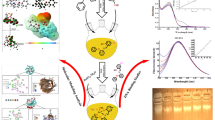Pulse radiolysis of resveratrol was carried out in aqueous solutions at pH ranging from 6.5 to 10.5. The one-electron oxidized species formed by the N•3 radicals at pH 6.5 and 10.5 were essentially the same with λmax at 420 nm and rate constant varying marginally (k = (5−6.5) × 109 dm3 mol−1 s−1). The nature of the transients formed by NO•2, NO• radical reaction at pH 10.5 was the same as that with N•3, due to the similarity in decay rates and the absorption maximum. Reaction of •OH radical with resveratrol at pH 7 gives an absorption maximum at 380 nm, attributed to the formation of carbon centered radical. The repair rates for the thymidine and guanosine radicals by resveratrol were approx. 1 × 109 dm3 mol−1 s−1, while the repair rate for tryptophan was lower by nearly an order of magnitude (k = 2 × 108 dm3 mol−1 s−1). The superoxide radical anion was scavenged by resveratrol, as well as by the Cu–resveratrol complex with k = 2 × 107 and 1.5 × 109 dm3 mol−1 s−1, respectively. Its reduction potential was also measured by cyclic voltammetry.
Similar content being viewed by others
Rights and permissions
About this article
Cite this article
Mahal, H.S., Mukherjee, T. Scavenging of reactive oxygen radicals by resveratrol: antioxidant effect. Res Chem Intermediat 32, 59–71 (2006). https://doi.org/10.1163/156856706775012941
Published:
Issue Date:
DOI: https://doi.org/10.1163/156856706775012941




